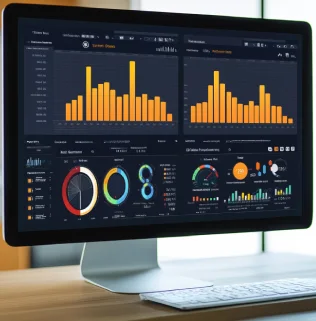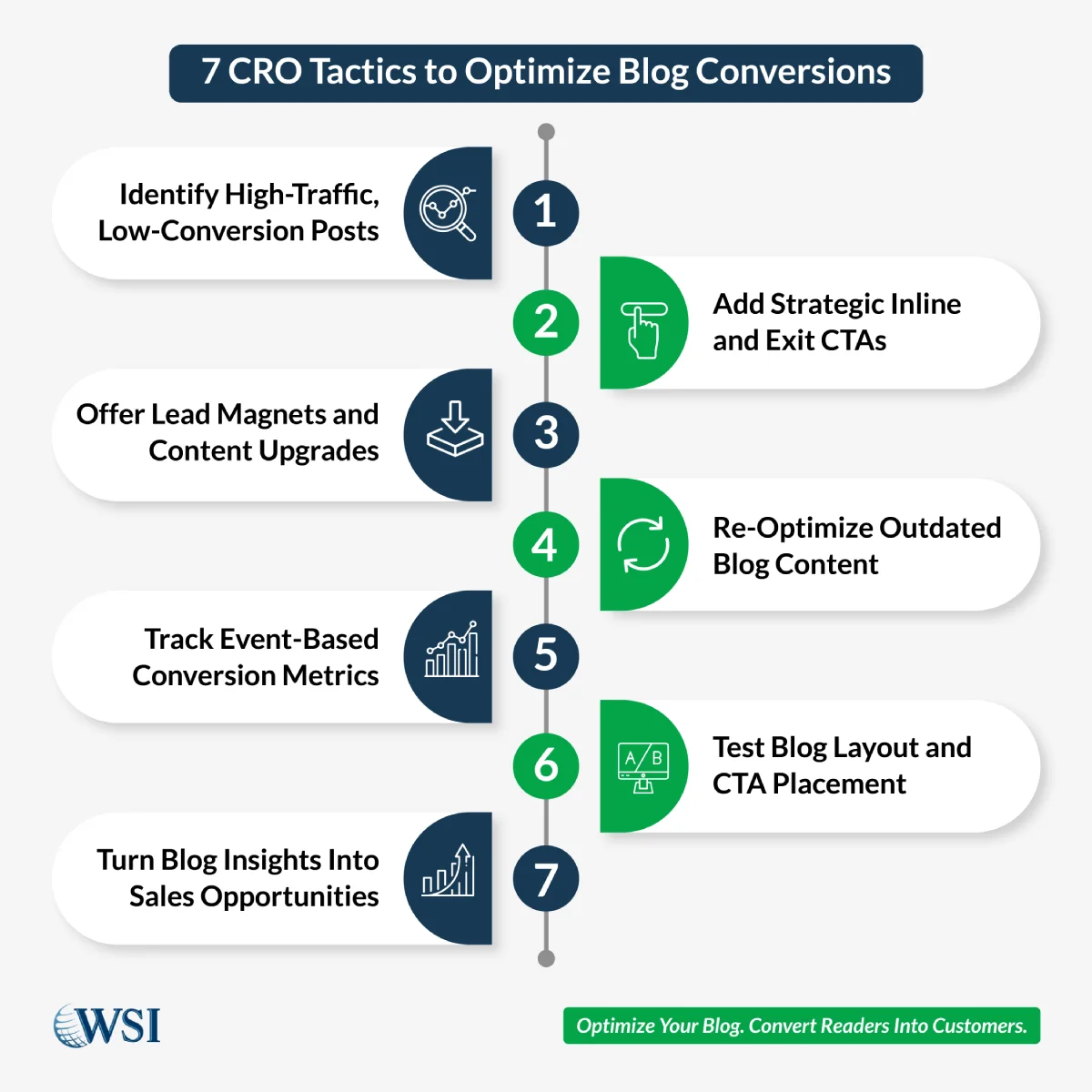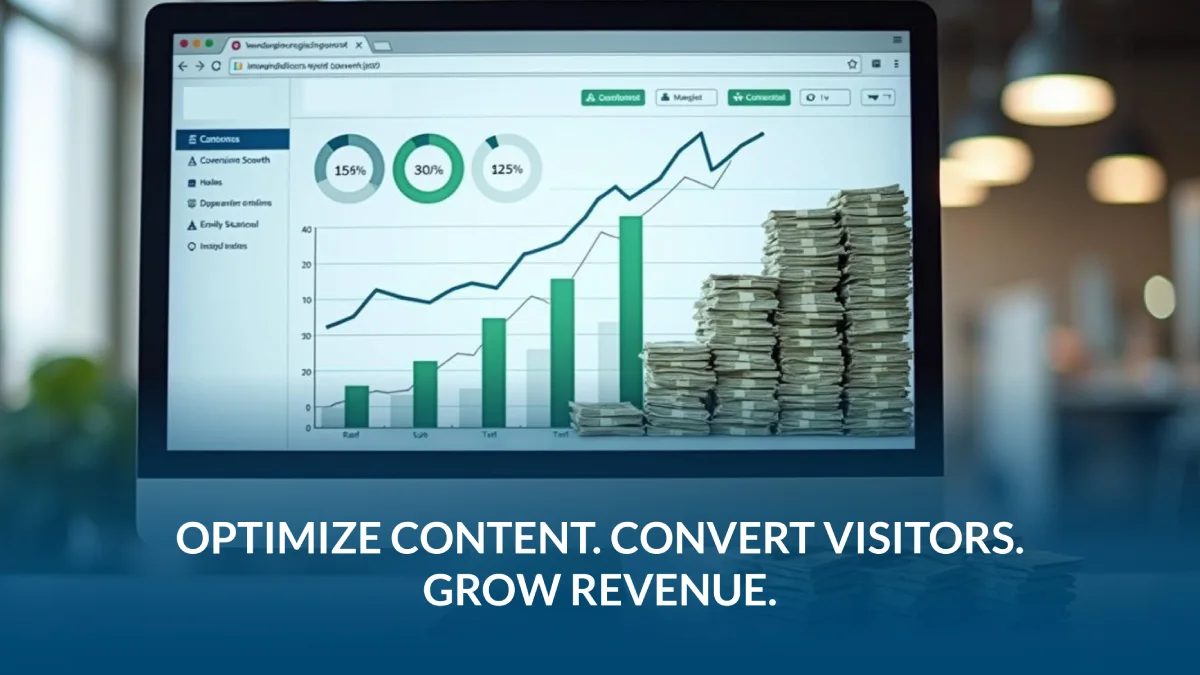Blog conversion optimization turns your content from a traffic source into a revenue engine. Instead of relying solely on page views, you focus on how each visitor moves toward a measurable action, whether that’s joining your list, booking a call, or requesting a quote. This article walks through practical CRO tactics to help you refine CTAs, measure performance, and increase blog leads using clear, data-driven systems that maximize ROI.
Key Takeaways:
- Blog conversion optimization turns passive readers into qualified leads through data-backed CRO tactics.
- Optimized CTAs, lead magnets, and event tracking bridge the gap between traffic and revenue.
- Consistent re-optimization keeps your blog relevant, persuasive, and profitable over time.
Contents
- 1 Why Blog Traffic Alone Doesn’t Drive Business Growth
- 2 The Conversion Opportunity Hidden in High-Traffic Posts
- 3 How to Identify Low-Converting but High-Traffic Blogs
- 4 Blog CTAs That Work: Inline, Text-Based, and Exit-Intent
- 5 How to Use Content Upgrades and Lead Magnets Strategically
- 6 Tracking Blog Conversions With Event-Based Analytics
- 6.1 1. Identify High-Traffic, Low-Conversion Posts
- 6.2 2. Add Strategic Inline and Exit CTAs
- 6.3 3. Offer Lead Magnets and Content Upgrades
- 6.4 4. Re-Optimize Outdated Blog Content
- 6.5 5. Track Event-Based Conversion Metrics
- 6.6 6. Test Blog Layout and CTA Placement
- 6.7 7. Turn Blog Insights Into Sales Opportunities
- 6.8 How often should I review blog conversion data?
- 6.9 Can I apply blog conversion optimization to older posts?
- 6.10 What’s the ideal CTA placement within a blog?
- 7 Updating and Re-Optimizing Blog Content for Relevance
Why Blog Traffic Alone Doesn’t Drive Business Growth
Traffic doesn’t always mean traction. Many business blogs see thousands of visitors monthly, yet few conversions. The problem isn’t visibility, it’s intent. Most blogs educate rather than convert, leaving a gap between awareness and action that wastes valuable opportunities.
Think of your blog as a digital storefront. High foot traffic looks great, yet if no one buys, the numbers mean little. Without a clear path from reading to doing, your audience slips away. Effective content marketing CRO bridges that gap, shaping each article to drive measurable outcomes.
Conversion requires frictionless flow. Visitors must find value fast, trust the message, and see the next step without confusion. When you apply blog conversion optimization, you turn one-time readers into recurring leads through clarity, timing, and relevance.
The Conversion Opportunity Hidden in High-Traffic Posts
High-traffic posts hold untapped value. They already attract visitors, which means your audience trusts the topic or keyword intent. The next move is to transform that attention into action by analyzing performance signals like bounce rate, time on page, and scroll depth.
A blog post with 5,000 monthly visitors converting at 1% yields 50 leads. Increasing that rate to 3% means 150 leads from the same traffic, triple the results without more ad spend. That’s the power of optimization over expansion.
Start with your top 10 performing URLs. Audit each for CTA visibility, placement, and message clarity. Add scroll-triggered offers that appear as readers reach decision-ready points. Subtle, well-timed nudges turn passive scrolling into deliberate engagement.

Turn Blog Traffic Into Real Leads
Your content already attracts readers. Now let’s convert them. Our team builds blog conversion systems that drive measurable ROI.
How to Identify Low-Converting but High-Traffic Blogs
Finding low-performing posts begins with analytics. Go to your analytics dashboard and filter by blog URLs. Sort by sessions to see which pages attract heavy traffic. Next, compare goal completions or conversion rates. High visits with low conversions indicate a CRO opportunity.
Once you have your list, examine each post for structural barriers. Are CTAs buried below the fold? Is the offer mismatched to the reader’s intent? Review your messaging. If a blog educates beginners, offering a free consultation might miss the mark. Instead, use an introductory resource or email series to capture interest.
Finally, connect heatmaps and scroll data. See where users stop reading. A sharp drop before your CTA means the message doesn’t hold attention long enough. Adjust formatting, break text visually, and reposition CTAs closer to engagement peaks. The goal isn’t more words; it’s better flow that keeps readers moving toward conversion.
Blog CTAs That Work: Inline, Text-Based, and Exit-Intent
CTAs are the turning point of blog lead generation. Every reader interaction either continues the conversation or ends it. Placement and format determine how natural the next step feels.
Inline CTAs fit directly within your content, appearing after strong insights or emotional triggers. They work because they feel contextual, like a natural extension of the paragraph. Text-based CTAs serve readers who ignore banners. Simple hyperlinks with persuasive verbs (“Get the full guide,” “See how it works”) blend seamlessly with the reading experience.
Exit-intent CTAs capture users just before they leave. Triggered by cursor movement, these prompts recover potential abandoners. The secret lies in tone, offering value instead of desperation. Instead of “Wait! Don’t leave,” try “Want a 3-step version of this guide?” It’s calm, helpful, and focused on user benefit.
A winning blog CTA strategy mixes all three types. Balance is key. Too many CTAs feel pushy, while too few miss conversion moments. A/B testing headline phrasing, button colors, and timing helps pinpoint what truly engages your audience.
How to Use Content Upgrades and Lead Magnets Strategically
Content upgrades and lead magnets turn curiosity into commitment. They bridge the gap between free content and subscriber engagement by offering extra value in exchange for contact information. The strategy works because it matches intent, each upgrade expands on the topic a reader already cares about.
Start with your highest-traffic blog posts. Identify where readers seek deeper help. Then create a relevant asset, like a checklist, template, or short eBook. For example, a post on “email subject lines” could feature a downloadable “50 Proven Subject Line Swipes.” Keep it specific. Generic lead magnets dilute engagement.
Placement matters. Offer upgrades contextually within the post, not just at the end. Pair the offer with brief benefit statements explaining what readers gain. Use concise forms with minimal fields, name and email only. The less friction, the higher the submission rate.
Finally, connect your lead magnet funnel to a follow-up sequence. Deliver the promised asset immediately, then nurture through helpful, non-salesy emails. The goal isn’t just capturing a lead; it’s beginning a relationship that turns readers into long-term customers.
Tracking Blog Conversions With Event-Based Analytics

Event-based analytics reveal how users truly interact with your blog. By tracking actions like CTA clicks, scroll depth, and form submissions, you see what drives engagement and what stalls it. Set clear conversion goals in your analytics platform and tag key events using tools like Google Tag Manager. Review data weekly to find high-traffic posts with low activity, then refine layout, CTAs, and messaging. Event tracking turns guesswork into proof, helping you shape smarter content marketing and CRO decisions. Over time, these insights transform your blog into a conversion engine that turns data into measurable growth.
1. Identify High-Traffic, Low-Conversion Posts
Your analytics dashboard will reveal which posts draw large audiences yet fail to generate conversions. These are your prime CRO opportunities. High visibility means interest already exists, the next step is diagnosing why readers stop short. Audit each post for mismatched CTAs, weak value propositions, or poor design flow. Simple adjustments, like repositioning CTAs higher or simplifying forms, can double your conversion rate without increasing traffic.
2. Add Strategic Inline and Exit CTAs
Your readers should always know what to do next. Inline CTAs feel natural because they appear inside your narrative, following a strong statement or insight. Exit-intent CTAs serve as safety nets, catching users who are about to leave. The trick is timing and relevance. Use exit prompts that offer helpful resources rather than generic pleas to stay. A well-written CTA can increase the number of visitors than standard pop-ups when aligned with content intent.
3. Offer Lead Magnets and Content Upgrades
Lead magnets turn engagement into relationships. Every high-performing post should include a value-driven resource connected to its topic. This could be a worksheet, checklist, or guide, something actionable that solves the next logical problem for your reader. Content upgrades positioned mid-article often convert higher than sidebar widgets, especially when paired with clean opt-in forms and persuasive copy that highlights the reader’s gain.
4. Re-Optimize Outdated Blog Content
Old content is silent potential. Revisit posts that once performed well but have faded. Refresh data, rewrite intros, and update CTAs with current offers. This not only boosts SEO but also enhances credibility with returning readers. Adding visuals, recent statistics, and new internal links improves time-on-page metrics, signals that drive better rankings and conversions together.
5. Track Event-Based Conversion Metrics
Each event tells a story. Monitor the percentage of users who interact with CTAs, scroll beyond 75% of a page, or click related links. These micro-metrics reveal where readers engage or drop off. Use A/B testing to see how small changes, headline shifts, color tweaks, and shorter forms, affect those numbers. Data-backed adjustments create consistent, compounding growth in your conversion rate over time.
6. Test Blog Layout and CTA Placement
Even the best CTA fails in the wrong spot. Test variations of your layout to find the visual hierarchy that keeps eyes moving and attention anchored. For long-form articles, include CTAs early (after 25% scroll), midway, and near the end. Consider mobile performance, buttons that appear perfectly on desktops can vanish below the fold on smaller screens. Heatmaps and session recordings will show exactly where readers engage most.
7. Turn Blog Insights Into Sales Opportunities
Data without action achieves nothing. The final step is connecting behavioral insights with your sales strategy. If one post consistently attracts readers interested in a specific service, tailor follow-up emails or remarketing ads around that intent. Align your blog funnel with your CRM so your sales team can reach leads while interest is still fresh. Every optimized post becomes an inbound sales asset.
FAQ
How often should I review blog conversion data?
Monthly reviews keep your metrics current without overwhelming your team. Focus on top-performing and lowest-performing posts to identify improvement opportunities. Over time, this regular review builds consistent growth.
Can I apply blog conversion optimization to older posts?
Absolutely. Historical posts often have strong SEO traction but weak CTAs or outdated content. Updating these pages with modern visuals, fresh data, and relevant offers can dramatically increase blog leads without writing new content.
What’s the ideal CTA placement within a blog?
Every post should have multiple touchpoints: one early (after 20–30% scroll), one mid-content, and one at the end. Testing different placements helps identify where readers are most responsive.
Updating and Re-Optimizing Blog Content for Relevance
CRO doesn’t end once a blog converts well. Audiences evolve, algorithms change, and offers shift. Re-optimization ensures your content remains relevant and competitive. Treat each post as a living asset that deserves maintenance.
Start by reviewing old articles quarterly. Check for outdated stats, broken links, and old CTAs that no longer reflect your brand. Update the structure for readability, short paragraphs, clear headings, and visuals that match current standards. Re-test your CTAs with fresh phrasing and new design variations to sustain engagement.
Consistency builds momentum. Every time you refine, your authority and performance improve. Blog conversion optimization is an ongoing system, not a one-time fix. When each article supports a clear conversion goal, your content turns into a compounding asset that drives leads month after month.
If you’re ready to build a content engine that performs at scale, speak with a WSI expert today and transform your blog into a lead-generation powerhouse.

Optimize Every Post for Conversions
From analytics setup to CTA testing, we help you turn blog engagement into measurable results. Start improving your blog’s ROI today.

